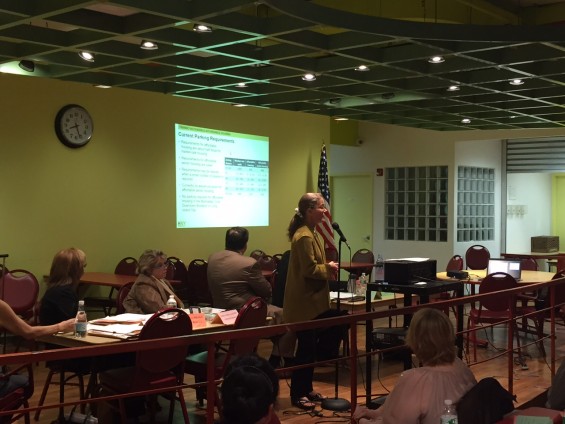
Penny Lee of DCP (Photo: QueensPost)
Nov. 9, 2015 By Christian Murray
The city’s push to amend the zoning code as a means to promote the construction of affordable housing was overwhelmingly rejected by Community Board 2 last Thursday.
The board took issue with several elements in the proposed amendments, such as the elimination of parking space requirements with affordable housing and the ability of builders to get around constructing affordable units in the first place.
Patrick O’Brien, chair of Community Board 2, said that while the amendments would not result in additional units in and of themselves, they do represent “one step in what is likely to be a series of steps toward the implementation of several hundred thousand affordable units under the admininistration’s plan.”
He said that the Board should look at the text amendments in the broader scope and noted “overarching concerns such as the lack of infrastructure,” whether it be schools, transportation or open space.
“It’s a shame we can’t be more supportative,” said Lisa Deller, chair of CB 2’s Land Use Committee. “We are huge advocates for affordable housing. We have been asking for affordable housing for 15 years.”
But there were several elements in the two amendments that proved to be problematic.
One of the proposed amendments, called Zoning for Quality and Affordability (ZQA), would raise the maximum building heights on Queens Boulevard.
The text would allow buildings constructed on Queens Boulevard, from 39th Street moving east, to be 20 feet taller (2 stories) if affordable senior housing or a long-term care facility went up. Developers would also get the additional 20 feet if they elected to use the optional inclusionary housing program.
“We can accommodate a little bit of an increase, but 20 feet is a problem,” O’Brien said, referring to how it could potentially change the look and character of the Boulevard.
Penny Lee, who represented the Department of City Planning, said that the additional height would not increase the number of units permitted (or square footage built). Instead, she said, it would give developers more flexibility in design, thereby incentivizing the creation of the affordable units.
The board also had problems with the amendment since it would eliminate the parking requirements at affordable housing and affordable senior housing in many parts of the district.
Lee said that in many areas where public transportation is available, low-income households own fewer cars and the off-street parking requirement is often not needed.
The Board did not agree.
The other text amendment, called Mandatory Inclusionary Housing (MIH), was also shot down by the Community Board.
The amendment would require that new developments of 10 units of more include 25 to 30 percent of permanently affordable housing when a district is rezoned to increase housing capacity.
MIH is particularly relevant in Long Island City since the city is planning to upzone the Court Square/Queens Plaza area.
MIH would kick in when that upzoning occurs. It would also apply to private developers citywide who seek a zoning change for a specific project.
But some of the details were troublesome to the board.
While the plan requires 25 percent to 30 percent of the units to be affordable, it provides developers with the ability to build those units in a separate building or on an entirely separate property within the same community board or within half a mile. The units do not have to be within the same market-rate building.
“People want to see affordable housing evenly within a project,” Deller said, adding that this aspect of the text amendment needs to be changed before the Board could approve it.
Developers who construct buildings that have between 10 and 25 units are able to put money in a fund in lieu of providing affordable housing. However, the board found this problematic since it did not know who is administrating the fund and how the funds would be spent.
The Board was also troubled by the potential for developers to wiggle out of building affordable housing. Developers would be able to apply to the Board of Standards and Appeals and claim the affordable housing requirement would create an “unnecessary hardship” for the developer on a site.
This option is often used by developers in other circumstances to get around zoning regulations. The Board wants this option to be gone.
The Board rejected both proposals almost unanimously with only one vote in favor of the MIH text amendment and two in favor of the ZQA amendment.
One Comment

Who on the Board was in favor of the MIH and ZQA as it was proposed?
Please I’d like to know why these people voted for it. Do they have ties to developers or are they developers themselves?